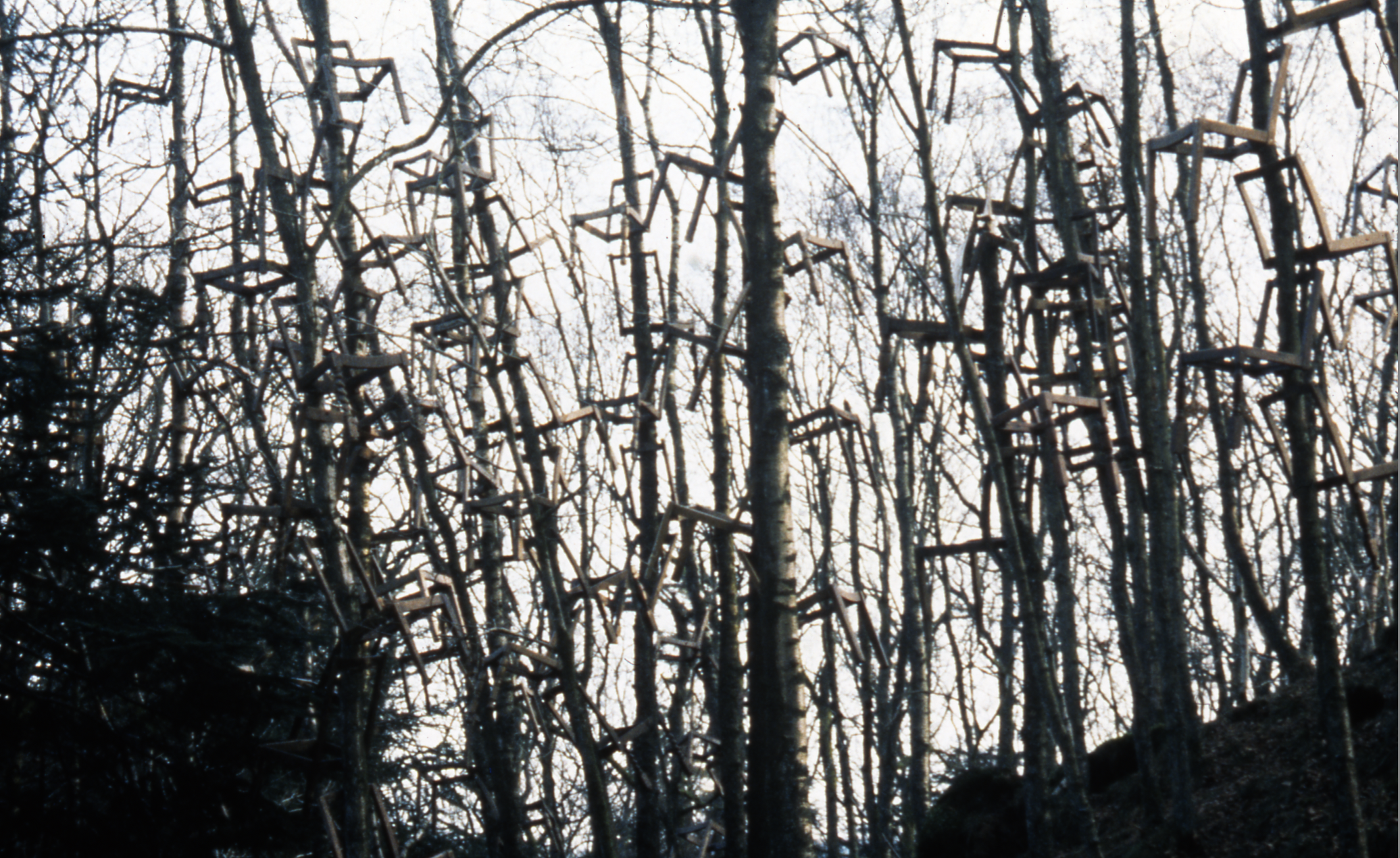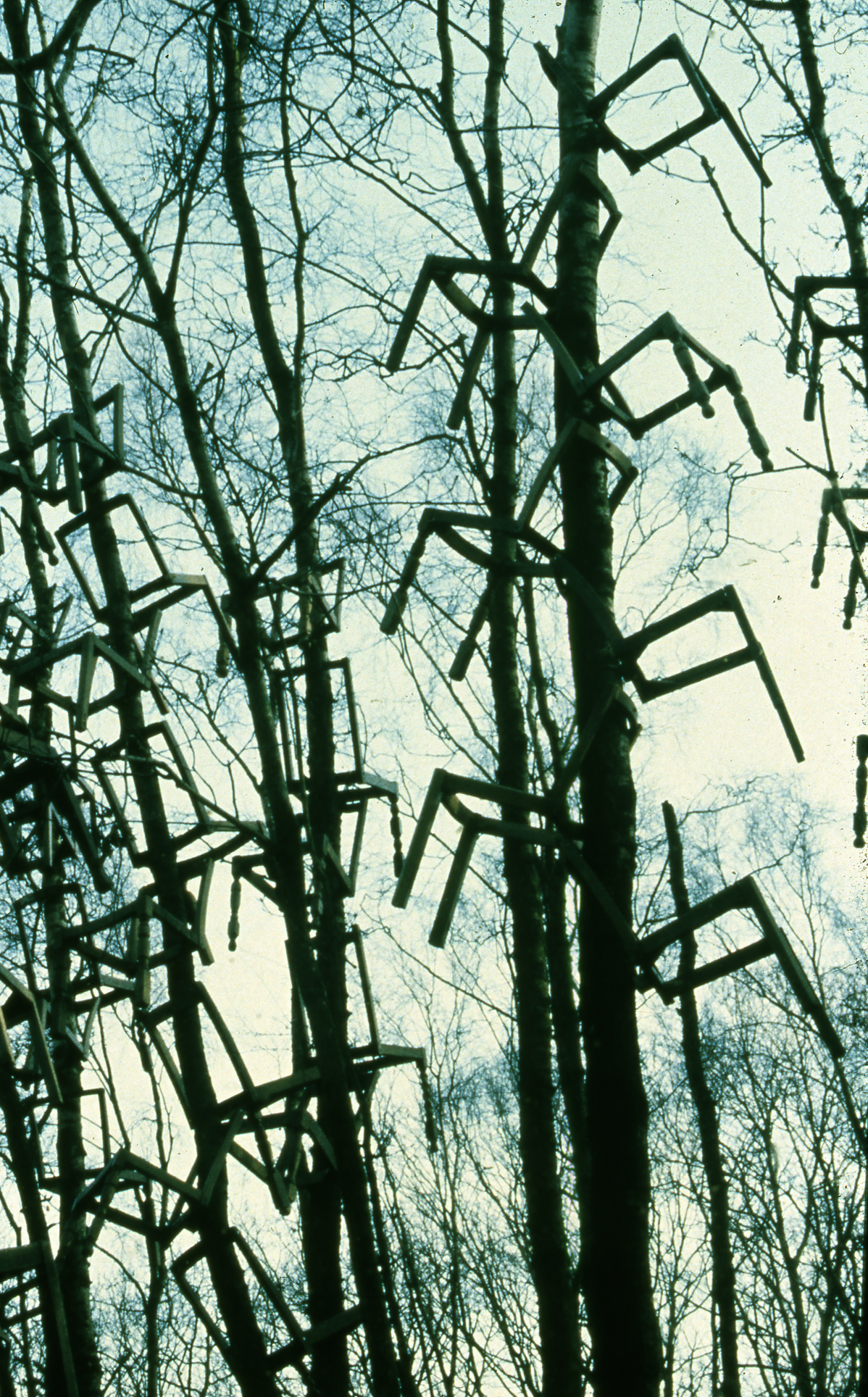Solid Oak
I was buying twelve dining room chairs from a junk shop in Hawkshead, a small town in Cumbria, northwest England.
“They’re solid oak – beautiful pieces” intoned the shopkeeper.
We agreed a price and I paid him and took them out onto the street and began sawing of their back legs. He came out and watched me for a moment.
“They’re solid fucking oak…what the fuck” and turned back into his shop perplexed.
I don’t blame him – if our roles had been reversed I would also have been perplexed. But I thank him for the title – Solid Oak. In retrospect perhaps I should have called it Solid Fucking Oak.
Bill Grant, the curator of the sculpture trail in Grizedale Forest, had called and asked if I would like to make a piece for the forest. This was not a call out of the blue. Ever since seeing David Nash’s piece Waterway on the Grizedale Sculpture Trail I had wanted to make a piece for that forest and I had been soliciting Bill for the opportunity to do so for a while.
Nash had very simply taken a stream flowing down a hillside and re-directed it for about 100 feet by hollowing out fallen tree branches and making a tributary – I saw this piece as a smart and beautiful intervention into nature that would change that ‘small’ environment for evermore.
Grizedale is a massive forest in England that provided much of the ship building oak that allowed Britain in the 18th century to proclaim that ‘Britannia Rules the Waves’. The ships made from the oaks grown in Grizdale had ruled the world. So Nash’s intervention was not unprecedented – and the consequence of his action was supremely rendered and conceivably as enduring as any empire.
Grizedale had also made the chairs that ruled the tables of the world – from the familial kitchen chair to the throne from which, in equal measure, the words of love, deceit, success and failure had emanated many thousands of times. When Bill called and the Grizedale commission came along the epiphany that hit me was to return some of those chairs to the forest. Something that had been harvested from the forest and machined into a tool to sit on could perhaps, when returned to the forest, have another value.
So I began collecting chairs - sets of chairs that had sat around kitchen tables for a generation or two and were still together - simple wooden chairs that had legs, a seat and a back. I began to see them, with their anthropomorphic associations, as a phenomenal raw material.
By cutting off the back legs and discarding the solid of the seat and the back, I no longer had a serviceable chair but a skeleton that nonetheless still spoke chair. The chair/machine that had been rendered from the forest had become useless in the material world and would be returned to the forest to survive as best it could.
I tramped around Grizedale for many days looking for a site. I came across the most beautiful spots and I came across massive industrial devastation - whole de-forested hillsides - gray stumps sticking out of a gray landscape. I eventually found my spot – a copse of adolescent trees, maybe a hundred, crowning the top of a hillock that ran along one side of the trail.
I arrived in Grizedale with a truck full of chairs and in a fit of enthusiasm ran them all up to the top of the hill and stacked them ready to start work the next day. Chairs with only two legs stack differently than chairs with four legs and I did notice that as I left in the early evening light from the trail below that they created a form that was homogenous, like a giant hedgehog. When I met Bill a few hours later in the pub and he had clearly already passed by to see what I was up to, he announced that he loved it – and I had to agree. Just stacking the chairs minus two of their legs at the top of a small hill in a forest made something to think about.
Bill was a retired oil executive and the conversation in the pub that night was clear. He said to me some variation of :
“You’re done. Great piece. Thanks.’”
In some ways this was refreshing. The corporate businessman had his product and it looked OK. Job done – move on. A far cry from the curators I had dealt with in the past that sometimes legitimately, but often not, inserted their own agenda onto an artwork. The difference with Bill was that he had no agenda; he was retired, he had been successful in his field and didn’t need to prove anything to anybody. Not to say that his questionable methods didn’t on occasion come to the fore – but he also understood that he was a novice when dealing with artists and their needs and ideas. Through his personality and energy he had lucked into the job of curator at Grizdale and it kept him feisty and curious through his retiring years. And with the help of another couple of pints we both agreed that the next day I would start building scaffolding towers around each tree and nailing the chairs into place from the top of the trees to the bottom in a particular pattern. The hedgehog would become a beehive.
Nailing sounds harsh – but it turns out that it is not. I was aware of the cruxifiction symbolism but chose to ignore it. I cannot say that driving a nail into a living tree does not hurt it – but during research to figure out how to attach the chairs I came across the simple fact that by driving metal spikes into venerable old trees saves them from the logging industry. An old living redwood with metal spikes driven through it at appropriate intervals is commercially useless and the tree will continue to flourish. Happily my research was correct – and 30 years later in spite of my nails the trees are maturing and growing strong. My sculpture is gone – fallen into the undergrowth to rot – not unlike the British Empire.
I knew that I was returning a raw material, fashioned by us into a chair/machine, back into its original habitat. I was conscious of doing it within the social context of the family and the intimacy that it implies. I understood that I was building a volatile empire. I was conscious that my small intervention would eventually fall and mulch back into the undergrowth and perhaps propagate new growth. And it did. Thirty years later of the 200 chairs that I nailed into the forest there is only one ragged chair left - there is nothing left to see of Solid Oak or Solid Fucking Oak – whichever you prefer.





